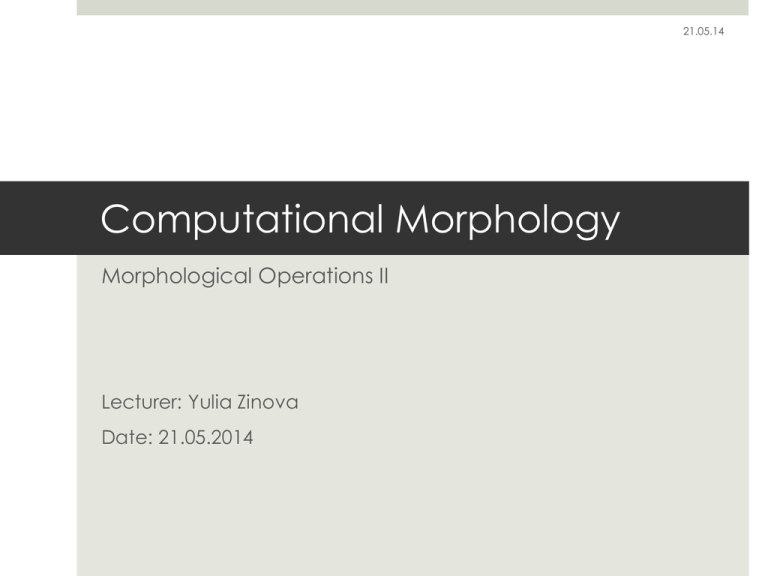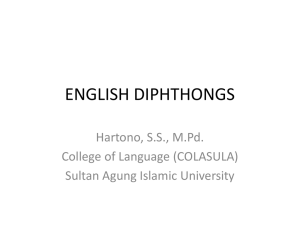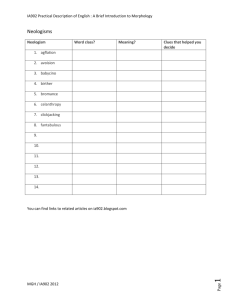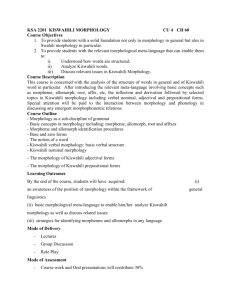slides by Kaja
advertisement

21.05.14 Computational Morphology Morphological Operations II Lecturer: Yulia Zinova Date: 21.05.2014 21.05.14 Literature Roark, B. and Sproat, R., 2007. Computational Approach to Morphology and Syntax. New York, NY: Oxford University Press. 21.05.14 Phonological changes induced by affixation Example 1: suffix –chen in German. The suffix induces umlaut on the vowel of the stem to which it attaches. Given the transducer Tuml that changes the vowels into their umlauted forms, the entry for –chen is as follows: X= Tuml [ε:chen] Some examples: Tochter- Töchterchen Maus - Mäuschen Kommode - Kommödchen 21.05.14 Phonological changes induced by affixation Transducer Tuml (reversed order): Id(Σ) Id(Σ) a:ä | o:ö u:ε ¬ a:u¬ a | a:uä 21.05.14 Subsegmental morphology “Morphological alternans can also be indicated with subsegmental information, such as change of a single feature.“ Example 2: genitive formation in Irish, where the genitive is marked by palatalizing the final consonant (sequence) of the base (nominative) stem: Nominative Genitive Translation bád /d/ báid /dy/ boat eolas /s/ eolais /∫/ knowledge sagart /rt/ sagairt /ryty/ priest 21.05.14 Subsegmental morphology Possible transducers for example 2: C(¬s):Cy | s:∫ Reversed order V:iV Normal order Id(Σ) V:iV s:∫ C(¬s):Cy Id(Σ) 21.05.14 Subtractive morphology An example (example 3) for subtractive morphology (also: truncation) is the plural stem formation in Koasati. The final rime of the singular stem (consisting of a final vowel and any following consonant) is deleted in the formation of the plural sten. The onset of the final syllable of the singular stem is retained. In our example we only consider phonological forms: Singular Plural [+pl] pitáf-li-n pít-li-n latáf-ka-n lat-ka-n tiwáp-li-n tiw-li-n atakáa-li-n aták-li-n iyyakohóp-ka-n iyyakóf-ka-n 21.05.14 Subtractive morphology Transducers for example 3: VV:ε | VC:ε li:li | ka:ka n:n Id(Σ) V:ε V:V C:C ε:[+pl] V:ε C:ε ε:[+pl] 21.05.14 Extrametrical infixation An example (example 4) for extrametrical infication can be found in Bontoc. The infix –um– marks different semantic infromation. The infix is prefixed to the word, ignoring the first consonant, if any: antjŏak umantjŏak kăwĭsat kumăwĭsat We will build two transducers – first one (T1)will insert a marker > (note that > ∉ Σ) in the appropriate location in the word, the second one (T2) will convert the marker to the infix –um– and add a morphosyntactic feature [+be] marking the construction at the end of the word. 21.05.14 Extrametrical infixation The two transducers for example 4: ε: > T1 C: C T2 V: V ε: > Σ:Σ > : um ε:+be Σ:Σ 21.05.14 Positively circumscribed infixation An example (example 5) of infixation that attaches to prosodically defined portion of the base is the language Ulwa. The prosodic unit is a iambic foot. The infixes (personal possessive markers in Ulwa) suffix to the first foot of the word. Initial form Translation With possessive marker Translation bilam fish bilmaki my fish dii snake diimamuih your (sg.) snake liima lemon liikama his lemon sikbilh horsefly siknibilh our (incl.) horsefly onyan onion onkinayan our (excl.) onion mistu cat miskanatu their cat anaalaka chin anaakanalaka their chin 21.05.14 Positively circumscribed infixation In example 5 the iambic feet include disyllables with a short vowel followed by either a long or short vowel (bilam, anaa), and monosyllables with either a long vowel (dii) or closed syllable with VC (sik). If the word is a single foot (bilam, dii) the affix is merely a suffix, otherwise the affix attaches to the first foot (as in liima). Using the marker > we can define the following strings: for single foot: C?(VC|VV|VVC|VCVV?C)> for others: C?(VC|VV|VCVV?)>CV











